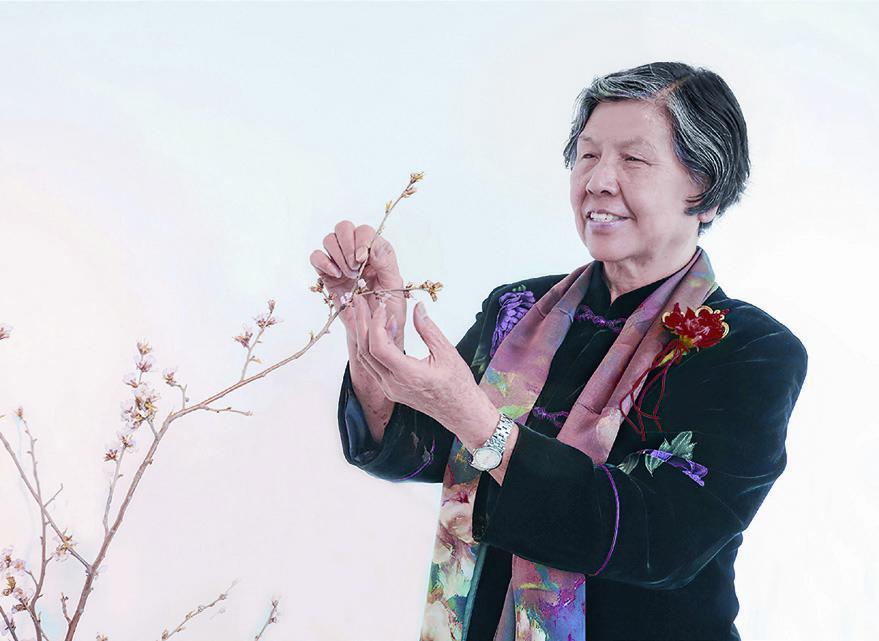The Art of Traditional Chinese Flower Arranging
By staff reporter DENG DI

IN Chinese culture, different plants represent dif- ferent kinds of human characteristics. Lotus is seen as lofty and virtuous; bamboo is upright; chrysanthemum is unyielding, in full bloom amid frost; and plum blossoms brave the cold of winter.
For thousands of years, a craft related to plants has added to their elegance, namely traditional Chinese flower arranging. This art form has a long history of 3,000 years and with its unique styles, it has become the origin and representative of the Oriental flower arranging genre.
In this art, the term flower is a general name that refers to plants with ornamental value, including flowers, branches, leaves, trunks, and dead wood. China has a vast land, diverse terrains, and different climates in its many regions, which help make all kinds of trees, shrubs, vines, and grass a veritable treasure trove for flower arrangement.
Over the past 3,000 years, social and economic conditions have changed, and so have artistic styles. As society has evolved, so too has the art of flower arranging, becoming popular with people and leading to a boom in its development.
On June 7, 2008, approved by the State Council, traditional flower arrangement was included in the National Intangible Cultural Heritage list, protected and supported by the government.
From Practical Use to Emotional Expression
In ancient China, under the influence of the philosophy of the unity of people and nature and the farming culture, people revered and loved nature, and plants were inseparable companions of them. In addition, influenced by primitive religions (especially witchcraft), the Chinese ancestors believed that people and plants could communicate telepathically. Therefore, they used plants to worship heaven, praying for favorable weather and thanking forefathers for their protection.
This period saw the beginning of traditional Chinese flower arranging art, which is called noncontainer flower arranging. Apart from worshipping, flowers were also made into bouquets to beautify peoples lives, to express love, and to honor virtue.
During the Spring and Autumn Period and the Warring States Period (770-221 BC), cut flowers were widely used. They were used in sacrificial ceremonies as part of dances and as a means of worship, and also often picked to be given as gifts of love and farewell.
In the Qin (221-207 BC) and Han(202 BC-AD 220) dynasties, flowers were arranged in containers. Later, when it came to the prosperous Tang(618-907) and Song (960-1279) dynasties, flower arranging art reached its zenith. The Tang palace often held peony flower arranging pageants with strict procedures. By the Song Dynasty, utilization of arranged flowers had become very popular among ordinary people when they interacted with each other.
The art has also experienced many twists and turns along the way. It was dealt a blow in the Yuan Dynasty (1279-1368), when the Mongols ruled the Central Plains for the first time, and the Han literati who did not want to work for them had no choice but to hide in the mountains, composing poems and arranging flowers. During this period, the traditional flower arranging art reached rock bottom. The art also suffered during the period from 1840 to 1978, when flower arranging remained stagnant. It was not until the implementation of the reform and opening-up policy in 1978 that the art was revived.
Efforts of an Octogenarian
It is thanks to an octogenarian that the art of traditional Chinese flower arranging became so widely known. Wang Lianying, a professor from the School of Landscape Architecture at Beijing Forestry University, has been dedicated to researching traditional Chinese flower arranging for over four decades.
Wang came to Beijing in 1956 to study landscaping and has been engaged in teaching since her graduation in 1960. An anecdote about Wang illustrates the important role she played in this art form.
Before China implemented the reform and opening-up policy in 1978, the domestic market was dominated by foreign flower arrangements, such as French and Japanese.
“At that time, many elderly artists in Hong Kong called me and said that they could send someone to help improve our flower arranging skills on the mainland if we needed it. It felt like the bitter truth,”said Wang. Determined to establish Chinas own study on flower arrangements, she began researching historical documents prior to the Qing Dynasty, and in 1987, with one of her colleagues, she set up the Beijing Flower Arranging Art Association.
Wang remembers that members traveled to museums and galleries across the country to obtain information. They searched several museums in Xian and recorded all the materials related to the history of traditional flower arranging and brought the information back to Beijing.
In 2002, workers from the then Ministry of Human Resources and Social Security approached her and added the profession of “flower arranger” to the list of national job categories.
Today, with the efforts of Wang and her team, this traditional Chinese art has become increasingly vibrant, and it remains an important part of her life.
Natures Craftsmanship
In Wangs eyes, Chinese art attaches great importance to the spiritual connotations expressed by art works. It regards art as the external manifestation of human character and a tool for the cultivation of the mind and personalities.
In traditional flower arranging, there are four basic forms to create a perfectly balanced arrangement: the upright, the tilt, the horizontal, and the drooping. There are also three basic principles: follow nature, learn from nature, and present nature in a better way. The use of all these techniques leaves no trace of the human element which makes this art very natural.
When selecting flower materials, flower arranging artists strive to “take their form, seek their meaning, and understand their connotation.” They not only show the flowers natural beauty, but also symbolically convey its humanistic spirit. For example, when inserting lotus flowers in a vase, the artist not only needs to show the flowers elegant, graceful natural beauty, but also its noble temperament.
As an inheritor of this intangible cultural heritage, for years, Wang has also been committed to the promotion of traditional flower arrangement skills. She and her colleagues organize training programs and set up courses at the Beijing Forestry University. Wang has many expectations of the younger generation. She hopes they will always love the life of flowers and plants, and when cutting them, will follow their natural shape, in a bid to create vibrant art works.
In the future, the association plans to train specialized traditional flower arrangement artists to help young people who love this art become professional.
Tips
Wooden Lines in Flower Arrangements
In every piece of flower arranging art work, there are always the presence of natural wooden lines, notably branches of various plants.
Branches or foliage are multi-functional. In the hands of flower arrangers, they construct the basic framework, add more color and vitality to the flowers, divide space, and add layers to the whole modeling.
Wooden lines are also emotionally arousing. Different lines remind people of different feelings. Vertical lines create an atmosphere of solemnity and firmness, horizontal lines unfold themselves freely, tilted lines look lively, while wavy lines are very athletic, giving a sense of rhythm.
Containers for Arranged Flowers
It was not until the Han Dynasty more than 2,000 years ago that China began to have records of flowers arranged in containers, according to historical data. A green glazed pottery pot with a pottery tree inside from the Han Dynasty was once unearthed.
Pottery and porcelain containers are one of the main features of traditional Chinese flower arranging art. Before arranging a bunch of flowers, artists would take the whole structure and the relationship among different parts into consideration. The flowers and branches are always considered first before the container, and the shape, texture, and color of the latter elements ought to be in harmony with the former elements.
Chinas First Museum for Flower-Arranging Art
Located in Fengtai District, Beijing, the Flower-Arranging Art Museum of China is the first museum in China dedicated to promoting the flower arranging art and covers an area of 2,500 square meters. Since its establishment, the museum has invited senior artists in this field to participate in the design and construction of the exhibition hall. It brings together the effort of top flower arranging artists from across the country, many of whom have donated the historical data they had collected and compiled for years to the museum.
It is also an international cultural exchange center for flower arranging art. The museum is well equipped with both traditional exhibition facilities and modern ones to provide visitors from both home and abroad with a unique spatial and visual experience.
- CHINA TODAY的其它文章
- China’s Auto Exports See Rapid Growth
- Xinjiang Population Maintains Steady Growth
- Xi Jinping Attends Second United Nations Global Sustainable Transport Conference
- China Launches Its Longest-Ever Crewed Mission for Space Station Construction
- Ecological Conservation Matters to All
- Even Mountains and Seas Cannot Come between People with Common Aspirations

